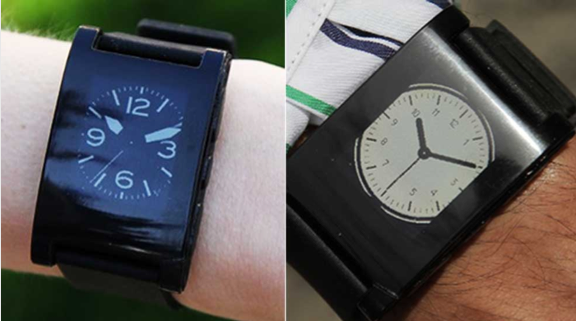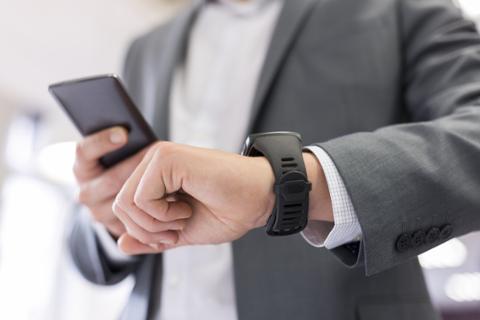 Pebble "smartwatches" could help guide the wearable-electronics market.[/caption] Dell wants a piece of the nascent wearable-electronics market. “We’re exploring ideas in that space,” Dell executive Sam Burd told The Guardian. “Having a watch on your wrist—that's pretty interesting, pretty appealing." Challenges include cost, he added, and building a device that people will actually want to wear. The wearable-electronics market has seen a surge of activity in recent months. Google is already marketing Google Glass, a portfolio of augmented-reality eyeglasses that feed data such as text messages and maps to a tiny screen embedded in the right lens. Meanwhile, Apple’s engineers and designers are reportedly hard at work on an “iWatch,” an iOS-supported timepiece capable of running a variety of apps; while Apple hasn’t confirmed that such a device is in development, many analysts and tech journalists are reasonably expectant that one will appear within the next few quarters. Whether or not Apple produces a tech-enhanced timepiece, it’s not alone in that segment: Google, LG, and Samsung all (reportedly) have similar wrist-hardware in development. In other words, if Dell comes out with a “D-Watch” or whatever, it’ll have a lot of company. In any case, wearable electronics offer some considerable design and engineering challenges. For starters, there’s the tiny issue of battery life: while people are willing to plug in their smartphone into the nearest power source at least once a day, they may rebel at the idea of having to frequently juice up a wristwatch or pair of eyeglasses. Second, watches’ and eyeglasses’ relatively small size means miniscule screens, which could create problems for anyone trying to create software for the devices. Google Glass features a single-cell 2.1-Wh (570-mAh) Lithium Polymer battery tucked into the frame, capable (according to Google) of roughly a day’s use on a single battery charge. The in-lens display offers a native resolution of 640x360, with pixels “roughly 1/8th the physical width of those on the iPhone 5’s retina display,” according to a recent teardown by Scott Torborg and Star Simpson. The Pebble “smart watch”—arguable the most prominent such device at the moment—is a customizable timepiece designed for interoperability with iOS and Google Android. In addition to alerting the user to incoming emails and texts, it offers a variety of apps for golf, running and other activities. It also features seven days’ worth of battery life, according to its creators, and supports Bluetooth. These early devices offer the foundation on which other companies will build. But as the market gets more crowded, it’ll become more difficult to develop those next-generation features that will truly stand out. Dell may be exploring wearable electronics as a way to bolster its revenues at a time when PC sales are anemic, but the company could also find itself in a real fight if it plunges into the category—and as it demonstrated with its ignoble attempts at producing a tablet to compete with Apple’s iPad, sometimes its experiments in new categories don’t turn out so well. Image: Pebble
Pebble "smartwatches" could help guide the wearable-electronics market.[/caption] Dell wants a piece of the nascent wearable-electronics market. “We’re exploring ideas in that space,” Dell executive Sam Burd told The Guardian. “Having a watch on your wrist—that's pretty interesting, pretty appealing." Challenges include cost, he added, and building a device that people will actually want to wear. The wearable-electronics market has seen a surge of activity in recent months. Google is already marketing Google Glass, a portfolio of augmented-reality eyeglasses that feed data such as text messages and maps to a tiny screen embedded in the right lens. Meanwhile, Apple’s engineers and designers are reportedly hard at work on an “iWatch,” an iOS-supported timepiece capable of running a variety of apps; while Apple hasn’t confirmed that such a device is in development, many analysts and tech journalists are reasonably expectant that one will appear within the next few quarters. Whether or not Apple produces a tech-enhanced timepiece, it’s not alone in that segment: Google, LG, and Samsung all (reportedly) have similar wrist-hardware in development. In other words, if Dell comes out with a “D-Watch” or whatever, it’ll have a lot of company. In any case, wearable electronics offer some considerable design and engineering challenges. For starters, there’s the tiny issue of battery life: while people are willing to plug in their smartphone into the nearest power source at least once a day, they may rebel at the idea of having to frequently juice up a wristwatch or pair of eyeglasses. Second, watches’ and eyeglasses’ relatively small size means miniscule screens, which could create problems for anyone trying to create software for the devices. Google Glass features a single-cell 2.1-Wh (570-mAh) Lithium Polymer battery tucked into the frame, capable (according to Google) of roughly a day’s use on a single battery charge. The in-lens display offers a native resolution of 640x360, with pixels “roughly 1/8th the physical width of those on the iPhone 5’s retina display,” according to a recent teardown by Scott Torborg and Star Simpson. The Pebble “smart watch”—arguable the most prominent such device at the moment—is a customizable timepiece designed for interoperability with iOS and Google Android. In addition to alerting the user to incoming emails and texts, it offers a variety of apps for golf, running and other activities. It also features seven days’ worth of battery life, according to its creators, and supports Bluetooth. These early devices offer the foundation on which other companies will build. But as the market gets more crowded, it’ll become more difficult to develop those next-generation features that will truly stand out. Dell may be exploring wearable electronics as a way to bolster its revenues at a time when PC sales are anemic, but the company could also find itself in a real fight if it plunges into the category—and as it demonstrated with its ignoble attempts at producing a tablet to compete with Apple’s iPad, sometimes its experiments in new categories don’t turn out so well. Image: Pebble Dell Exploring Wearable Electronics
[caption id="attachment_10831" align="aligncenter" width="576"]  Pebble "smartwatches" could help guide the wearable-electronics market.[/caption] Dell wants a piece of the nascent wearable-electronics market. “We’re exploring ideas in that space,” Dell executive Sam Burd told The Guardian. “Having a watch on your wrist—that's pretty interesting, pretty appealing." Challenges include cost, he added, and building a device that people will actually want to wear. The wearable-electronics market has seen a surge of activity in recent months. Google is already marketing Google Glass, a portfolio of augmented-reality eyeglasses that feed data such as text messages and maps to a tiny screen embedded in the right lens. Meanwhile, Apple’s engineers and designers are reportedly hard at work on an “iWatch,” an iOS-supported timepiece capable of running a variety of apps; while Apple hasn’t confirmed that such a device is in development, many analysts and tech journalists are reasonably expectant that one will appear within the next few quarters. Whether or not Apple produces a tech-enhanced timepiece, it’s not alone in that segment: Google, LG, and Samsung all (reportedly) have similar wrist-hardware in development. In other words, if Dell comes out with a “D-Watch” or whatever, it’ll have a lot of company. In any case, wearable electronics offer some considerable design and engineering challenges. For starters, there’s the tiny issue of battery life: while people are willing to plug in their smartphone into the nearest power source at least once a day, they may rebel at the idea of having to frequently juice up a wristwatch or pair of eyeglasses. Second, watches’ and eyeglasses’ relatively small size means miniscule screens, which could create problems for anyone trying to create software for the devices. Google Glass features a single-cell 2.1-Wh (570-mAh) Lithium Polymer battery tucked into the frame, capable (according to Google) of roughly a day’s use on a single battery charge. The in-lens display offers a native resolution of 640x360, with pixels “roughly 1/8th the physical width of those on the iPhone 5’s retina display,” according to a recent teardown by Scott Torborg and Star Simpson. The Pebble “smart watch”—arguable the most prominent such device at the moment—is a customizable timepiece designed for interoperability with iOS and Google Android. In addition to alerting the user to incoming emails and texts, it offers a variety of apps for golf, running and other activities. It also features seven days’ worth of battery life, according to its creators, and supports Bluetooth. These early devices offer the foundation on which other companies will build. But as the market gets more crowded, it’ll become more difficult to develop those next-generation features that will truly stand out. Dell may be exploring wearable electronics as a way to bolster its revenues at a time when PC sales are anemic, but the company could also find itself in a real fight if it plunges into the category—and as it demonstrated with its ignoble attempts at producing a tablet to compete with Apple’s iPad, sometimes its experiments in new categories don’t turn out so well. Image: Pebble
Pebble "smartwatches" could help guide the wearable-electronics market.[/caption] Dell wants a piece of the nascent wearable-electronics market. “We’re exploring ideas in that space,” Dell executive Sam Burd told The Guardian. “Having a watch on your wrist—that's pretty interesting, pretty appealing." Challenges include cost, he added, and building a device that people will actually want to wear. The wearable-electronics market has seen a surge of activity in recent months. Google is already marketing Google Glass, a portfolio of augmented-reality eyeglasses that feed data such as text messages and maps to a tiny screen embedded in the right lens. Meanwhile, Apple’s engineers and designers are reportedly hard at work on an “iWatch,” an iOS-supported timepiece capable of running a variety of apps; while Apple hasn’t confirmed that such a device is in development, many analysts and tech journalists are reasonably expectant that one will appear within the next few quarters. Whether or not Apple produces a tech-enhanced timepiece, it’s not alone in that segment: Google, LG, and Samsung all (reportedly) have similar wrist-hardware in development. In other words, if Dell comes out with a “D-Watch” or whatever, it’ll have a lot of company. In any case, wearable electronics offer some considerable design and engineering challenges. For starters, there’s the tiny issue of battery life: while people are willing to plug in their smartphone into the nearest power source at least once a day, they may rebel at the idea of having to frequently juice up a wristwatch or pair of eyeglasses. Second, watches’ and eyeglasses’ relatively small size means miniscule screens, which could create problems for anyone trying to create software for the devices. Google Glass features a single-cell 2.1-Wh (570-mAh) Lithium Polymer battery tucked into the frame, capable (according to Google) of roughly a day’s use on a single battery charge. The in-lens display offers a native resolution of 640x360, with pixels “roughly 1/8th the physical width of those on the iPhone 5’s retina display,” according to a recent teardown by Scott Torborg and Star Simpson. The Pebble “smart watch”—arguable the most prominent such device at the moment—is a customizable timepiece designed for interoperability with iOS and Google Android. In addition to alerting the user to incoming emails and texts, it offers a variety of apps for golf, running and other activities. It also features seven days’ worth of battery life, according to its creators, and supports Bluetooth. These early devices offer the foundation on which other companies will build. But as the market gets more crowded, it’ll become more difficult to develop those next-generation features that will truly stand out. Dell may be exploring wearable electronics as a way to bolster its revenues at a time when PC sales are anemic, but the company could also find itself in a real fight if it plunges into the category—and as it demonstrated with its ignoble attempts at producing a tablet to compete with Apple’s iPad, sometimes its experiments in new categories don’t turn out so well. Image: Pebble
 Pebble "smartwatches" could help guide the wearable-electronics market.[/caption] Dell wants a piece of the nascent wearable-electronics market. “We’re exploring ideas in that space,” Dell executive Sam Burd told The Guardian. “Having a watch on your wrist—that's pretty interesting, pretty appealing." Challenges include cost, he added, and building a device that people will actually want to wear. The wearable-electronics market has seen a surge of activity in recent months. Google is already marketing Google Glass, a portfolio of augmented-reality eyeglasses that feed data such as text messages and maps to a tiny screen embedded in the right lens. Meanwhile, Apple’s engineers and designers are reportedly hard at work on an “iWatch,” an iOS-supported timepiece capable of running a variety of apps; while Apple hasn’t confirmed that such a device is in development, many analysts and tech journalists are reasonably expectant that one will appear within the next few quarters. Whether or not Apple produces a tech-enhanced timepiece, it’s not alone in that segment: Google, LG, and Samsung all (reportedly) have similar wrist-hardware in development. In other words, if Dell comes out with a “D-Watch” or whatever, it’ll have a lot of company. In any case, wearable electronics offer some considerable design and engineering challenges. For starters, there’s the tiny issue of battery life: while people are willing to plug in their smartphone into the nearest power source at least once a day, they may rebel at the idea of having to frequently juice up a wristwatch or pair of eyeglasses. Second, watches’ and eyeglasses’ relatively small size means miniscule screens, which could create problems for anyone trying to create software for the devices. Google Glass features a single-cell 2.1-Wh (570-mAh) Lithium Polymer battery tucked into the frame, capable (according to Google) of roughly a day’s use on a single battery charge. The in-lens display offers a native resolution of 640x360, with pixels “roughly 1/8th the physical width of those on the iPhone 5’s retina display,” according to a recent teardown by Scott Torborg and Star Simpson. The Pebble “smart watch”—arguable the most prominent such device at the moment—is a customizable timepiece designed for interoperability with iOS and Google Android. In addition to alerting the user to incoming emails and texts, it offers a variety of apps for golf, running and other activities. It also features seven days’ worth of battery life, according to its creators, and supports Bluetooth. These early devices offer the foundation on which other companies will build. But as the market gets more crowded, it’ll become more difficult to develop those next-generation features that will truly stand out. Dell may be exploring wearable electronics as a way to bolster its revenues at a time when PC sales are anemic, but the company could also find itself in a real fight if it plunges into the category—and as it demonstrated with its ignoble attempts at producing a tablet to compete with Apple’s iPad, sometimes its experiments in new categories don’t turn out so well. Image: Pebble
Pebble "smartwatches" could help guide the wearable-electronics market.[/caption] Dell wants a piece of the nascent wearable-electronics market. “We’re exploring ideas in that space,” Dell executive Sam Burd told The Guardian. “Having a watch on your wrist—that's pretty interesting, pretty appealing." Challenges include cost, he added, and building a device that people will actually want to wear. The wearable-electronics market has seen a surge of activity in recent months. Google is already marketing Google Glass, a portfolio of augmented-reality eyeglasses that feed data such as text messages and maps to a tiny screen embedded in the right lens. Meanwhile, Apple’s engineers and designers are reportedly hard at work on an “iWatch,” an iOS-supported timepiece capable of running a variety of apps; while Apple hasn’t confirmed that such a device is in development, many analysts and tech journalists are reasonably expectant that one will appear within the next few quarters. Whether or not Apple produces a tech-enhanced timepiece, it’s not alone in that segment: Google, LG, and Samsung all (reportedly) have similar wrist-hardware in development. In other words, if Dell comes out with a “D-Watch” or whatever, it’ll have a lot of company. In any case, wearable electronics offer some considerable design and engineering challenges. For starters, there’s the tiny issue of battery life: while people are willing to plug in their smartphone into the nearest power source at least once a day, they may rebel at the idea of having to frequently juice up a wristwatch or pair of eyeglasses. Second, watches’ and eyeglasses’ relatively small size means miniscule screens, which could create problems for anyone trying to create software for the devices. Google Glass features a single-cell 2.1-Wh (570-mAh) Lithium Polymer battery tucked into the frame, capable (according to Google) of roughly a day’s use on a single battery charge. The in-lens display offers a native resolution of 640x360, with pixels “roughly 1/8th the physical width of those on the iPhone 5’s retina display,” according to a recent teardown by Scott Torborg and Star Simpson. The Pebble “smart watch”—arguable the most prominent such device at the moment—is a customizable timepiece designed for interoperability with iOS and Google Android. In addition to alerting the user to incoming emails and texts, it offers a variety of apps for golf, running and other activities. It also features seven days’ worth of battery life, according to its creators, and supports Bluetooth. These early devices offer the foundation on which other companies will build. But as the market gets more crowded, it’ll become more difficult to develop those next-generation features that will truly stand out. Dell may be exploring wearable electronics as a way to bolster its revenues at a time when PC sales are anemic, but the company could also find itself in a real fight if it plunges into the category—and as it demonstrated with its ignoble attempts at producing a tablet to compete with Apple’s iPad, sometimes its experiments in new categories don’t turn out so well. Image: Pebble 
